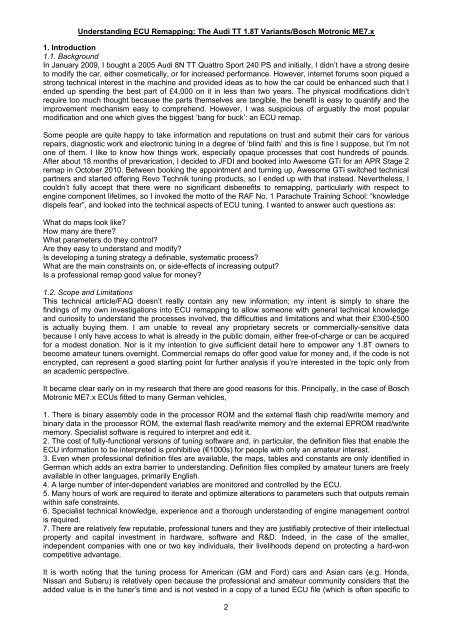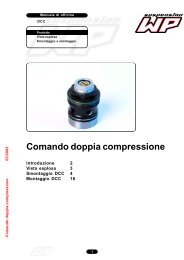Understanding ECU Remapping: The Audi TT 1.8 T - contiman - Free
Understanding ECU Remapping: The Audi TT 1.8 T - contiman - Free
Understanding ECU Remapping: The Audi TT 1.8 T - contiman - Free
Create successful ePaper yourself
Turn your PDF publications into a flip-book with our unique Google optimized e-Paper software.
<strong>Understanding</strong> <strong>ECU</strong> <strong>Remapping</strong>: <strong>The</strong> <strong>Audi</strong> <strong>TT</strong> <strong>1.8</strong>T Variants/Bosch Motronic ME7.x<br />
1. Introduction<br />
1.1. Background<br />
In January 2009, I bought a 2005 <strong>Audi</strong> 8N <strong>TT</strong> Quattro Sport 240 PS and initially, I didn’t have a strong desire<br />
to modify the car, either cosmetically, or for increased performance. However, internet forums soon piqued a<br />
strong technical interest in the machine and provided ideas as to how the car could be enhanced such that I<br />
ended up spending the best part of £4,000 on it in less than two years. <strong>The</strong> physical modifications didn’t<br />
require too much thought because the parts themselves are tangible, the benefit is easy to quantify and the<br />
improvement mechanism easy to comprehend. However, I was suspicious of arguably the most popular<br />
modification and one which gives the biggest ‘bang for buck’: an <strong>ECU</strong> remap.<br />
Some people are quite happy to take information and reputations on trust and submit their cars for various<br />
repairs, diagnostic work and electronic tuning in a degree of ‘blind faith’ and this is fine I suppose, but I’m not<br />
one of them. I like to know how things work, especially opaque processes that cost hundreds of pounds.<br />
After about 18 months of prevarication, I decided to JFDI and booked into Awesome GTi for an APR Stage 2<br />
remap in October 2010. Between booking the appointment and turning up, Awesome GTi switched technical<br />
partners and started offering Revo Technik tuning products, so I ended up with that instead. Nevertheless, I<br />
couldn’t fully accept that there were no significant disbenefits to remapping, particularly with respect to<br />
engine component lifetimes, so I invoked the motto of the RAF No. 1 Parachute Training School: “knowledge<br />
dispels fear”, and looked into the technical aspects of <strong>ECU</strong> tuning. I wanted to answer such questions as:<br />
What do maps look like?<br />
How many are there?<br />
What parameters do they control?<br />
Are they easy to understand and modify?<br />
Is developing a tuning strategy a definable, systematic process?<br />
What are the main constraints on, or side-effects of increasing output?<br />
Is a professional remap good value for money?<br />
1.2. Scope and Limitations<br />
This technical article/FAQ doesn’t really contain any new information; my intent is simply to share the<br />
findings of my own investigations into <strong>ECU</strong> remapping to allow someone with general technical knowledge<br />
and curiosity to understand the processes involved, the difficulties and limitations and what their £300-£500<br />
is actually buying them. I am unable to reveal any proprietary secrets or commercially-sensitive data<br />
because I only have access to what is already in the public domain, either free-of-charge or can be acquired<br />
for a modest donation. Nor is it my intention to give sufficient detail here to empower any <strong>1.8</strong>T owners to<br />
become amateur tuners overnight. Commercial remaps do offer good value for money and, if the code is not<br />
encrypted, can represent a good starting point for further analysis if you’re interested in the topic only from<br />
an academic perspective.<br />
It became clear early on in my research that there are good reasons for this. Principally, in the case of Bosch<br />
Motronic ME7.x <strong>ECU</strong>s fitted to many German vehicles,<br />
1. <strong>The</strong>re is binary assembly code in the processor ROM and the external flash chip read/write memory and<br />
binary data in the processor ROM, the external flash read/write memory and the external EPROM read/write<br />
memory. Specialist software is required to interpret and edit it.<br />
2. <strong>The</strong> cost of fully-functional versions of tuning software and, in particular, the definition files that enable the<br />
<strong>ECU</strong> information to be interpreted is prohibitive (€1000s) for people with only an amateur interest.<br />
3. Even when professional definition files are available, the maps, tables and constants are only identified in<br />
German which adds an extra barrier to understanding. Definition files compiled by amateur tuners are freely<br />
available in other languages, primarily English.<br />
4. A large number of inter-dependent variables are monitored and controlled by the <strong>ECU</strong>.<br />
5. Many hours of work are required to iterate and optimize alterations to parameters such that outputs remain<br />
within safe constraints.<br />
6. Specialist technical knowledge, experience and a thorough understanding of engine management control<br />
is required.<br />
7. <strong>The</strong>re are relatively few reputable, professional tuners and they are justifiably protective of their intellectual<br />
property and capital investment in hardware, software and R&D. Indeed, in the case of the smaller,<br />
independent companies with one or two key individuals, their livelihoods depend on protecting a hard-won<br />
competitive advantage.<br />
It is worth noting that the tuning process for American (GM and Ford) cars and Asian cars (e.g. Honda,<br />
Nissan and Subaru) is relatively open because the professional and amateur community considers that the<br />
added value is in the tuner’s time and is not vested in a copy of a tuned <strong>ECU</strong> file (which is often specific to<br />
2



